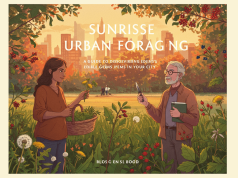In the hustle and bustle of city life, the idea of forest bathing might seem laughably out of reach. Traditionally rooted in the Japanese practice of shinrin-yoku—which translates as “forest bath”—this meditative approach to wellness invites participants to stroll slowly through serene woodlands, engaging all five senses to foster deep relaxation, mental clarity, and a profound sense of well-being. Yet, many of us live miles away from ancient forests or sprawling national parks. Daily commutes, busy schedules, and the concrete sprawl often leave little room for immersive nature experiences. Urban forest bathing adapts the essence of this time-honored ritual for the modern city dweller, showing you how to reap its restorative benefits without leaving the city limits. Through mindful observation, gentle movement, and intentional breathing, you can transform mundane urban spaces into your personal green sanctuary. In this post, we’ll delve into the philosophy behind urban forest bathing and share seven actionable strategies to cultivate a deeper nature connection in your everyday life.
What is Urban Forest Bathing?

Originating from the ancient Japanese concept of shinrin-yoku, forest bathing emphasizes a deliberate, immersive engagement with the natural world. Participants are encouraged to slow down, leave electronic devices behind, and use all five senses—sight, sound, touch, smell, and even taste—to fully absorb their surroundings. The goal isn’t a strenuous trek or an ambitious itinerary; it’s about cultivating mindful presence that fosters calm and a profound sense of connectedness.
Urban forest bathing translates these principles into metropolitan settings. Rather than avoiding the city, this practice leverages available green spaces—community gardens, pocket parks, tree-lined boulevards, and indoor plant corners—to create moments of sensory immersion. By shifting your mindset from viewing nature as a distant escape to embracing it as an integral part of daily life, you can tap into the same physiological and psychological benefits attributed to traditional forest bathing. Studies show that even brief encounters with greenery can reduce cortisol levels, sharpen focus, and elevate mood, making urban forest bathing a powerful antidote to high-stress environments.
Importantly, urban forest bathing is adaptable: it can be as simple as spending five minutes on a balcony surrounded by potted greenery or as intentional as planning a weekend “forest mini-retreat” in a local arboretum. The essence lies in purposeful slowness, sensory curiosity, and gratitude for the living world—even amid skyscrapers and traffic. Embrace the idea that nature is not a far-off commodity but a dynamic presence waiting to be noticed at every turn.
7 Ways to Bring Nature into Your Urban Life

- Create a Mini Green Zone at HomeBegin by selecting a variety of low-maintenance indoor plants—such as pothos, snake plants, or ZZ plants—and group them in a dedicated corner or shelf. Use decorative pots, plant stands, or a tiered shelf to build vertical interest. The visual density of foliage stimulates the senses and provides a constant backdrop of living texture. Make watering, pruning, and casual leaf-dusting part of your daily ritual, turning plant care into a form of mindful practice. Over time, you’ll notice calmer breathing and an enlivened mood each time you step into your indoor green haven.
- Embrace Roof and Balcony BiophiliaIf you have outdoor space—no matter how small—transform it into a verdant retreat. Install railing planters, vertical living walls, or a collection of potted trees and shrubs. Intermix flowering vines with aromatic herbs like lavender or mint to create both a visual and sensory oasis. Add a comfortable chair or floor cushions and dedicate 10–15 minutes each morning or evening to sit quietly, breathe deeply, and observe the dance of leaves and insects around you. This elevated patch of green will become your daily window to the sky and a reminder of nature’s restorative rhythms.
- Seek Out Urban Wilderness PocketsMost cities harbor hidden pockets of wilderness—abandoned rail lines turned greenways, native plant restoration sites, or small ravines alongside rivers and canals. Research local conservation groups or park services to identify these under-the-radar havens. Plan a weekly excursion, camera or journal in hand. Walk slowly, touch the bark of mature trees, listen for bird calls, and let your attention drift to the rustle of leaves. These urban micro-forests can deliver genuine forest-bathing benefits in just 20–30 minutes of mindful presence.
- Practice Mindful Walks in City ParksRather than power-walking for exercise or scrolling your phone between steps, allocate one walk per week solely for sensory exploration. Choose a park route with varied plantings—evergreen groves, flowering meadows, and water features if possible. Walk at half your usual pace, pause at least five times to close your eyes, inhale deeply, and listen to ambient sounds. Notice textures underfoot, the warmth of sunlight on your skin, and subtle scent shifts in the air. By decoupling walking from multitasking, you deepen your attunement to the environment and activate your parasympathetic nervous system for true relaxation.
- Use Nature Sounds and AromatherapyWhen stepping outside isn’t an option, simulate green spaces indoors with nature soundscapes and essential oils. Play high-quality recordings of forest ambience—birdsong, gentle breezes in pine trees, or flowing streams—through speakers or headphones. Complement the sound bath with a diffuser filled with cedarwood, pine, or eucalyptus oil. The combined auditory and olfactory cues can elicit physiological responses akin to real outdoor exposure, lowering heart rate and encouraging mental calm. Schedule these sessions during lunch breaks or pre-sleep wind-down to maximize restorative effects.
- Incorporate Natural Materials in Your SpaceBeyond plants, infuse your living or working environment with natural elements—reclaimed wood furniture, stone coasters, woven rattan baskets, and cotton or linen textiles. Place a small bowl of river stones or a driftwood centerpiece on your desk. The tactile qualities of these materials encourage grounded, sensory engagement whenever you touch or move them. Over time, the presence of organic textures cultivates a subtle but continuous sense of connection to the living world, even in the most urban of interiors.
- Schedule Regular Digital-Free Nature DatesBlock out windows in your calendar labeled “Nature Date” and commit to spending that time device-free. Invite a friend, partner, or go solo. Choose a local botanical garden, riverside boardwalk, or community greenway. Leave smartphones in your bag and focus on real-time experiences—sketching a leaf pattern, tasting fresh berries, or simply reclining on the grass to watch clouds drift by. By honoring these appointments as non-negotiable self-care, you build consistency and deepen your appreciation for local ecosystems that might otherwise go unnoticed.
Bonus Tips for Deepening Your Practice

• Maintain a nature journal: Record sensory observations, sketches, and reflections after each green encounter. Over weeks and months, you’ll uncover patterns in your responses and track your evolving emotional well-being.
• Join or form a forest-bathing group: Local meetup organizations and wellness centers often offer guided urban forest-bathing sessions. Sharing the experience with others can amplify its benefits and foster community support.
• Blend movement with mindfulness: Incorporate slow tai chi, qigong, or gentle yoga stretches into your green zones. The combination of intentional movement and natural stimuli deepens sensory immersion and releases physical tension.
• Explore seasonal shifts: Make note of flowering cycles, leaf color changes, and migrating wildlife in your area. Observing nature’s rhythms cultivates a sense of wonder and reminds us that growth and change are constants, even in the city.
Conclusion
Urban forest bathing distills the essence of shinrin-yoku into practices you can weave into daily metropolitan life. Whether you’re nurturing a mini indoor jungle, meditating on a balcony at sunrise, enjoying Pop-Up Picnics in local parks, or discovering hidden woodlands in your neighborhood, these seven approaches invite you to pause, breathe, and engage your senses. As you deepen your nature connection, you’ll likely notice reduced stress, heightened focus, and a greater sense of belonging in the world around you. Embrace these rituals not as occasional escapes but as ongoing invitations to recognize nature’s presence in every corner of the concrete jungle. Your next restorative breath is closer than you think—it’s waiting in the green moment you create today.









